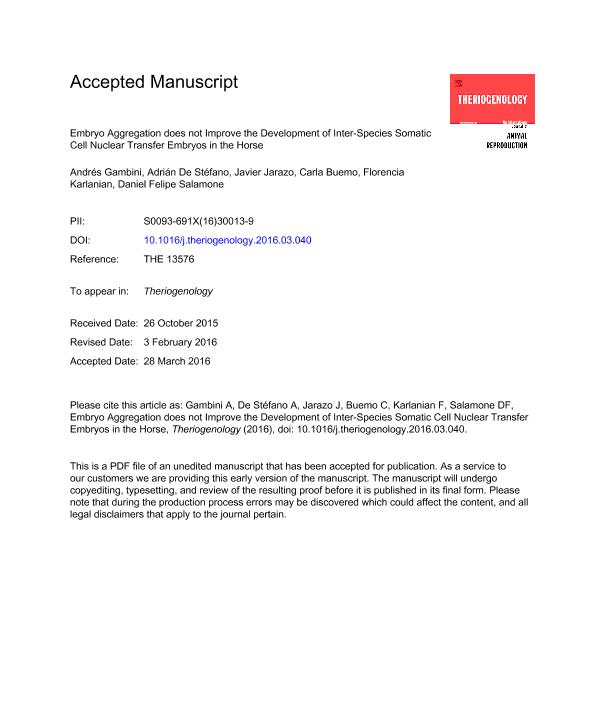Mostrar el registro sencillo del ítem
dc.contributor.author
Gambini, Andres

dc.contributor.author
de Stefano, Adrián

dc.contributor.author
Jarazo, Javier
dc.contributor.author
Buemo, Carla Paola

dc.contributor.author
Karlanian, Florencia

dc.contributor.author
Salamone, Daniel Felipe

dc.date.available
2018-07-13T19:05:27Z
dc.date.issued
2016-09
dc.identifier.citation
Gambini, Andres; de Stefano, Adrián; Jarazo, Javier; Buemo, Carla Paola; Karlanian, Florencia; et al.; Embryo aggregation does not improve the development of interspecies somatic cell nuclear transfer embryos in the horse; Elsevier Science Inc; Theriogenology; 86; 4; 9-2016; 1081-1091
dc.identifier.issn
0093-691X
dc.identifier.uri
http://hdl.handle.net/11336/52083
dc.description.abstract
The low efficiency of interspecies somatic cell nuclear transfer (iSCNT) makes it necessary to investigate new strategies to improve embryonic developmental competence. Embryo aggregation has been successfully applied to improve cloning efficiency in mammals, but it remains unclear whether it could also be beneficial for iSCNT. In this study, we first compared the effect of embryo aggregation over in vitro development and blastocyst quality of porcine, bovine, and feline zona-free (ZF) parthenogenetic (PA) embryos to test the effects of embryo aggregation on species that were later used as enucleated oocytes donors in our iSCNT study. We then assessed whether embryo aggregation could improve the in vitro development of ZF equine iSCNT embryos after reconstruction with porcine, bovine, and feline ooplasm. Bovine- and porcine-aggregated PA blastocysts had significantly larger diameters compared with nonaggregated embryos. On the other hand, feline- and bovine-aggregated PA embryos had higher blastocyst cell number. Embryo aggregation of equine-equine SCNT was found to be beneficial for embryo development as we have previously reported, but the aggregation of three ZF reconstructed embryos did not improve embryo developmental rates on iSCNT. In vitro embryo development of nonaggregated iSCNT was predominantly arrested around the stage when transcriptional activation of the embryonic genome is reported to start on the embryo of the donor species. Nevertheless, independent of embryo aggregation, equine blastocyst-like structures could be obtained in our study using domestic feline-enucleated oocytes. Taken together, these results reported that embryo aggregation enhance in vitro PA embryo development and embryo quality but effects vary depending on the species. Embryo aggregation also improves, as expected, the in vitro embryo development of equine-equine SCNT embryos; however, we did not observe positive effects on equine iSCNT embryo development. Among oocytes from domestic animals tested in our study, the feline ooplasm might be the most appropriate recipient to partially allow preimplantation embryo development of iSCNT equine embryos.
dc.format
application/pdf
dc.language.iso
eng
dc.publisher
Elsevier Science Inc

dc.rights
info:eu-repo/semantics/openAccess
dc.rights.uri
https://creativecommons.org/licenses/by-nc-nd/2.5/ar/
dc.subject
Aggregation
dc.subject
Embryo
dc.subject
Equine
dc.subject
Interspecies
dc.subject
Parthenogenetic
dc.subject
Scnt
dc.subject.classification
Otras Biotecnología Agropecuaria

dc.subject.classification
Biotecnología Agropecuaria

dc.subject.classification
CIENCIAS AGRÍCOLAS

dc.title
Embryo aggregation does not improve the development of interspecies somatic cell nuclear transfer embryos in the horse
dc.type
info:eu-repo/semantics/article
dc.type
info:ar-repo/semantics/artículo
dc.type
info:eu-repo/semantics/publishedVersion
dc.date.updated
2018-06-22T14:37:09Z
dc.journal.volume
86
dc.journal.number
4
dc.journal.pagination
1081-1091
dc.journal.pais
Estados Unidos

dc.description.fil
Fil: Gambini, Andres. Universidad de Buenos Aires. Facultad de Agronomía. Pabellón de Zootecnica. Laboratorio de Biotecnología Animal; Argentina. Consejo Nacional de Investigaciones Científicas y Técnicas; Argentina
dc.description.fil
Fil: de Stefano, Adrián. Universidad de Buenos Aires. Facultad de Agronomía. Pabellón de Zootecnica. Laboratorio de Biotecnología Animal; Argentina
dc.description.fil
Fil: Jarazo, Javier. Universidad de Buenos Aires. Facultad de Agronomía. Pabellón de Zootecnica. Laboratorio de Biotecnología Animal; Argentina
dc.description.fil
Fil: Buemo, Carla Paola. Universidad de Buenos Aires. Facultad de Agronomía. Pabellón de Zootecnica. Laboratorio de Biotecnología Animal; Argentina. Consejo Nacional de Investigaciones Científicas y Técnicas; Argentina
dc.description.fil
Fil: Karlanian, Florencia. Universidad de Buenos Aires. Facultad de Agronomía. Pabellón de Zootecnica. Laboratorio de Biotecnología Animal; Argentina
dc.description.fil
Fil: Salamone, Daniel Felipe. Universidad de Buenos Aires. Facultad de Agronomía. Pabellón de Zootecnica. Laboratorio de Biotecnología Animal; Argentina. Consejo Nacional de Investigaciones Científicas y Técnicas; Argentina
dc.journal.title
Theriogenology

dc.relation.alternativeid
info:eu-repo/semantics/altIdentifier/doi/http://dx.doi.org/10.1016/j.theriogenology.2016.03.040
dc.relation.alternativeid
info:eu-repo/semantics/altIdentifier/url/https://www.sciencedirect.com/science/article/pii/S0093691X16300139
Archivos asociados
